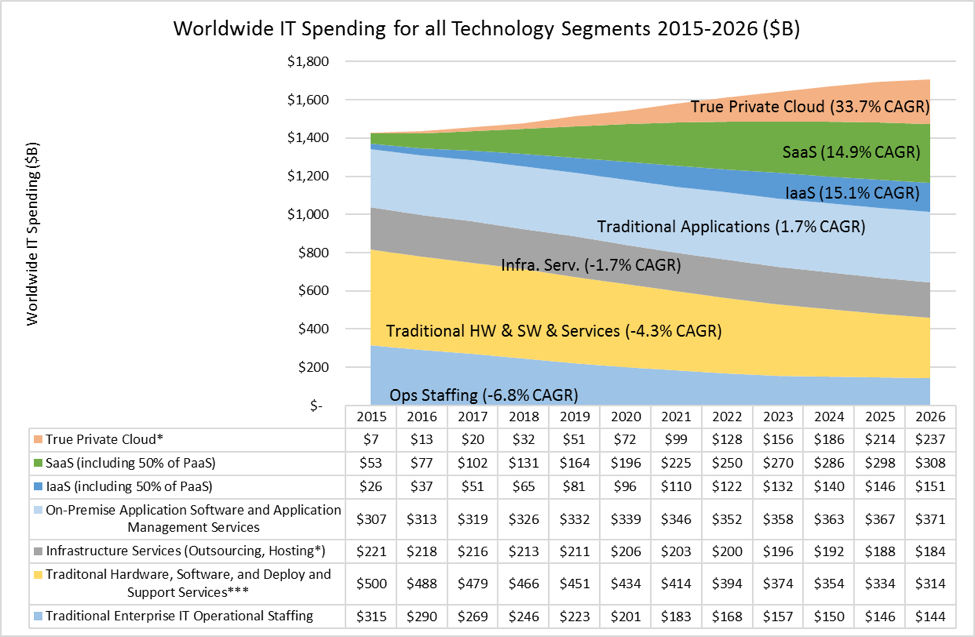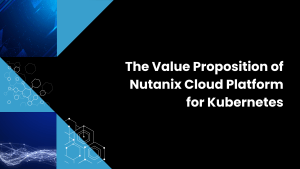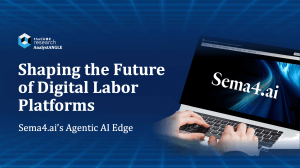![]()
Premise
Infrastructure performance is and will continue to be essential to enterprise and ISV developers of Digital Differentiation systems. UniGrid will provide an architectural framework for enabling Digital Differentiation.
Digital Differentiation with Business Analytics
Digital Differentiation is using data to provide competitive differentiation of enterprise and governmental products and services. Differentiation can come from reduced costs for business processes, faster time to deliver, and faster time to market for new products and services.
In general, the more relevant data analyzed and applied to business processes the greater the potential for Digital Differentiation. Great strides have been made in the ability to use Business Analytics (i.e., artificial intelligence (AI), advanced analytics, big data, machine learning and other techniques) to model business process systems.
The potential of Business Analytics can be realized in one of two ways:
- Making decision makers smarter:
- Business Analytics tools such as data warehouses and data lakes have been operating for decades, and many advanced software tools are available to help business executives to interactively analyze data.
- The historic time-to-data result for analysis is usually measured in hours or days.
- Although important for strategic decisions, the return on investment for tactical decisions is mixed.
- Making systems smarter:
- Business Analytic tools to enable business process optimization, acceleration and automation directly into existing systems of record.
- When the analysis can be imbedded into existing systems of record, the return on investment is very high.
- How quickly the data is analyzed becomes the gate for effective integration into business systems of record. Second or sub-second response time is usually required for machine-to-human interaction, and sub-millisecond response time for machine-to-machine response time.
- Although rewriting existing systems of record and integrating would probably result in better systems, the cost and elapsed time to rep-and-replace existing systems in almost all cases is both prohibitive and carries very high business risks.
In summary, the best return for extracting business value from Digital Differentiation is to initially create complex models of business processes. These are then used to create smaller models, which connect real-time Business Analytics to existing systems of record. The larger models can be also extended with external models, and used to augment strategic decisions. Figure 1 below illustrates the linkages between systems of record and Business Analytics to create Systems of Intelligence.

Source: © Wikibon 2018
Cloud Computing and Digital Differentiation
Many people and companies have argued that cost of cloud computing is the most important important metric. Infrastructure-as-a-Service (IaaS) vendors offer shared storage at cents per gigabyte, and shared off-peak processing is pennies on the dollar. However, Figure 1 above shows that there needs to be highly performant hardware and software to connect systems of record and Business Analytics. Wikibon has defined True Private Cloud to describe systems dedicated to enterprise computing, either on premises or collocated in mega-datacenters. Wikibon believes that UniGrid architectures will be important in enabling existing systems to deliver far greater business value, and will be especially important in performant True Private Clouds.
Equally, many Independent System Vendors (ISVs) computing systems help in reducing cost for undifferentiated business processes. Increasingly, these types of system are being addressed by SaaS vendors, which themselves may use IaaS systems to reduce cost, especially in the early years. However, SaaS ISVs that provide the systems to help reduce the cost of undifferentiated business processes have to Digitally Differentiate their SaaS systems! Over time, the SaaS vendors find they need more control over the availability, reliability, recoverability, functionality and performance of their systems in order provide Digital Differentiation. To achieve this, these systems are often moved from public cloud to a True Private Cloud. The specific PaaS elements required by the SaaS system are installed on top of the True Private Cloud systems.
Wikibon has defined True Private Cloud as hyper-converged infrastructure with public-cloud automation and orchestration features commensurate with the workloads to be supported. Figure 2 below shows the growth of IaaS, SaaS, and True Private Cloud (either on premises or in collocated in mega-datacenters in the period 2015-2026. Wikibon believes that a significant portion of True Private Cloud will utilize UniGrid architectures.

Source: © Wikibon 2017 from Wikibon Research on 2017 True Private Cloud Forecast and Market Shares (Figure 3).
UniGrid and Digital Differentiation
UniGrid has the following architectural characteristics:
- Networking and IO is separated and offloaded from the processor to NICs and offload processors (ARM processors). This will significantly lower the amount of IO and networking overhead on the processors (~50%), and significantly lower the cost of computing.
- The IO protocol is based on NVMe and NVMe-oF (NVMe over Fabric), or equivalent protocols. This architecture provides connection of processor to data in microseconds.
- The NVMe protocol can be RoCE (RDMA over Converged Ethernet), InfiniBand, Fibre Channel, or TP/IP.
-
The architecture allows any processor to connect to any data source (e.g., volume) directly, with minimal overhead.
- The storage medium will be 3D NAND.
- The processor memory will be Hybrid DRAM and 3D NAND.
- The architecture can scale to 1,000s of processor nodes, and will become composable infrastructure. Processor nodes can be different architectures and different configurations.
- The IO density and bandwidth will be sufficient to support advanced “snapshot” capabilities, and allow virtual copies of consistent data to be available for multiple applications without data movement.
- New metadata constructs and file systems that can exploit these UniGrid systems are expected in 2018.
This architecture will open up completely new ways of combining applications with 1,000 times the data that traditional systems of record can achieve. The value of the UniGrid architecture to the stakeholders of business systems include:
- Universal access to data for business across a Grid of processors and data. Enterprise businesses and functions will be able to conceive of systems based on any business data, not just “their” function’s data stored in “their” function’s applications.
- Unitary to system administrators. It will employ cloud-like management interfaces capable of composing and administrating any type of workload through common consoles for the whole Grid.
- Uniform data access for developers. UniGrid will remove the IO constraints of traditional application design. UniGrid will allow simplification of data access, and far higher application data densities. For example, UniGrid will allow the direct integration of systems of record with business analytic systems. The amount of data in a transaction or unit of work can be up to 1,000 time the amount of data of traditional systems.
Conclusions & Recommendations
This research illustrates that Business Analytics can significantly improve existing systems of record by integrating them directly into existing systems of record. Figure 3 below illustrates the difference between traditional systems and systems with a UniGrid architecture. Existing systems can only support limited amounts of data, and connecting to other systems is relatively very slow. UniGrid architectures will allow differentiated hardware and software to be utilized for Business Analytics (e.g., with additional GPUs and high-bandwidth processors). Equally, the systems of record can use differentiated hardware and software aimed at smaller blocks of data with very low latency requirements.

Source: © Wikibon 2017
The potential business value for such integrated systems is very high. Wikibon will be publishing additional research in the UniGrid series. Wikibon believes UniGrid architectures will be delivered in phases. Early examples are the Micron announcement of reference architecture SolidScale, an end-to-end NVME Over Fabric solution with Excelero NVMesh, Mellanox RoCE, Micron SSDs, and Supermicro servers. All the large-scale cloud vendors are actively engaged in implementing storage and network desegregation in their hyper-converged platforms. IBM, Kaminario, NetApp, and Pure X are early announcers of some of the NVMe over Fabric solutions.
Action Item
Wikibon strongly recommends that CTOs and executive management investigate and adopt UniGrid architectures as a vital part of their strategic infrastructure plan.
Footnotes:
Updates to Figure 1 and some minor updates and additions to the conclusions sections were made 1/1/2018


